MacBook Pro 2016 Review
MacBook Pro 2016
A stunning laptop and a compromised experience (updated)
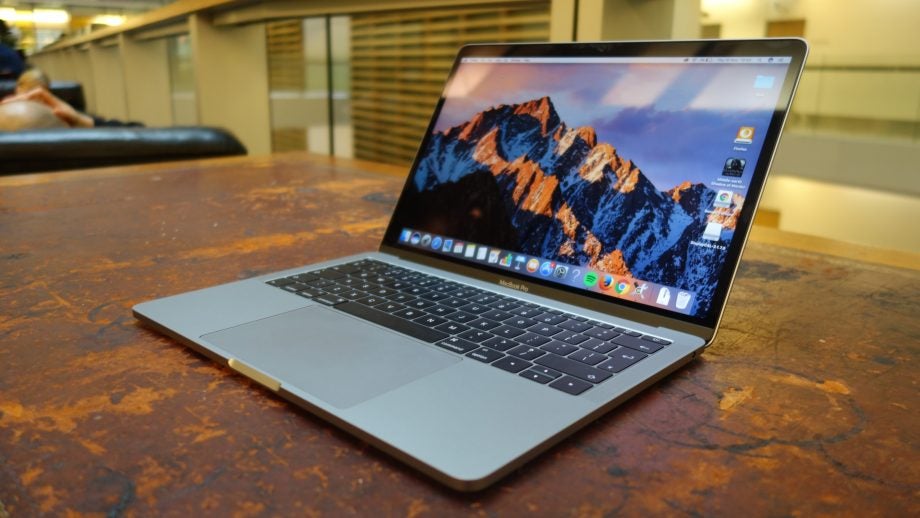
Sections
- Page 1 MacBook Pro 2016 Review
- Page 2 Performance, battery life and screen Review
Verdict
Pros
- Stunning design and build quality
- Pro-quality screen
- Super-fast SSD
- Silky-smooth macOS
Cons
- Middling processor
- Where are the ports?
- Too expensive given performance
Key Specifications
- Review Price: £1449.00 (starting at £1249)
- 2-3.1GHz Intel Core i5-6360U processor (upgradable to 3.4GHz Core i7)
- 8GB 1,866MHz LPDDR3 memory (upgradable to 16GB)
- Intel Iris Graphics 540
- 2,560 x 1,600-pixel Retina display
- 2 x Thunderbolt 3/USB Type-C combination ports, 3.5mm headset jack
- 256GB PCIe SSD (512GB and 1TB available)
- 802.11ac Wi-Fi and Bluetooth 4.2
- 15mm thick
- Weight: 1.37kg
The original conclusion of this article on the second page was also updated on 12 October 2017.
What is the MacBook Pro 2016?
The MacBook Pro line has long represented the pinnacle of stylish and sturdy laptop design, and the overhauled edition is a huge refinement on Apple’s already great formula.
However, when it comes to value for money, the MacBook Pro is less appealing than ever. For creatives, the 13-inch MacBook Pro base model is the cheapest up-to-date entry into the macOS ecosystem – but that doesn’t mean it offers the best value. On review here is the base-model 13-inch model from late 2016. Apple has since updated the Pro with newer processors, but the fundamentals are the same: same ports, same screen battery and near-identical performance.
- Looking for the model with the Touch Bar? Check our 13-inch MacBook Pro with Touch Bar review .
- And the 15-inch model? Read the 15-inch MacBook Pro review
Watch: 13-inch MacBook Pro video review
Related: Best Laptops
MacBook Pro 2016 – Design and Build
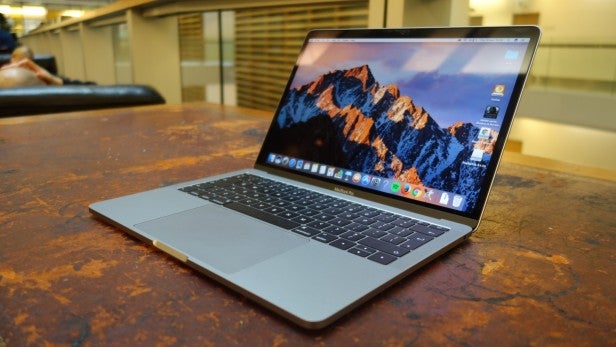
After years of crying out for a serious makeover for the MacBook Pro 2016, Apple has finally delivered. This is the most beautiful laptop on the market today and sets a new standard for other manufacturers.
The unibody design, machined from a single piece of aluminium, is as attractive as ever. To the delight of my colleagues Apple sent in the new, Space Grey option for review, but my personal preference is still for the classic, lighter-coloured design. However, greater choice is always a good thing.
The MacBook Pro is incredibly light at just 1.37kg, although it’s far from the lightest in its class. The Dell XPS 13 takes that honour, with its equivalent, non-touchscreen model weighing in at only 1.2kg. That machine also has a smaller footprint thanks to its tiny bezel.
Related: Intel Core i processors explained
Closed, the MacBook Pro still looks significantly smaller than your average 13.3-inch laptop – Apple has achieved this by trimming the fat around the bezel. The lid itself is thin, too, and this is likely the reason Apple has ditched the famous, light-up Apple logo for a tinted mirror in the same shape.
In terms of connections, the laptop includes two Thunderbolt 3 ports that double up as USB Type-C 3.1 ports, and a 3.5mm headphone jack. 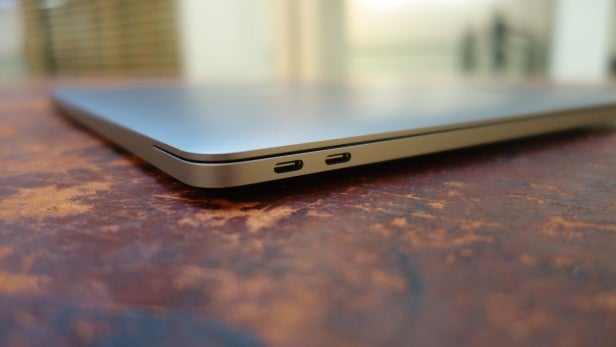
Related: USB-C explained
Sounds simple? Not exactly. Apple has done that Apple thing of completely embracing a new connection format without a graceful transition period. While all its rivals now include one Thunderbolt port alongside a couple of regular, old-fashioned USB ports and an SD card reader, Apple has ditched the lot and expects you to deal with it. Whatever the justification, unless you’re starting afresh, you’ll have to spend extra cash on adapters while you make the transition.
Of the two included ports, one is likely to always be occupied for charging, unless you buy an external dock. I won’t go through the full list of adapters and docks available, but if you’re buying from Apple – and you purchase a couple of them – then you’ll likely end up adding between £40-100 to your bill.
If you opt for third-party hardware, my advice is to pick a reputable brand; there are all manner of no-name accessories out there that might damage your new machine.
Let’s not forget, however, that Thunderbolt 3 is an amazing standard. It can send and receive huge amounts of power and up to 40GB/secs of data, meaning it can hook up to high-end storage arrays and monitors directly. Nobody can deny it’s an impressive piece of tech and having two on a laptop is actually pretty rare. Most laptops these days have one or none.
I can live with the change, but I can’t live with Apple’s refusal to include any adapters in the box. A simple USB Type-C to USB or Ethernet adapter would have been a welcome addition to the package.
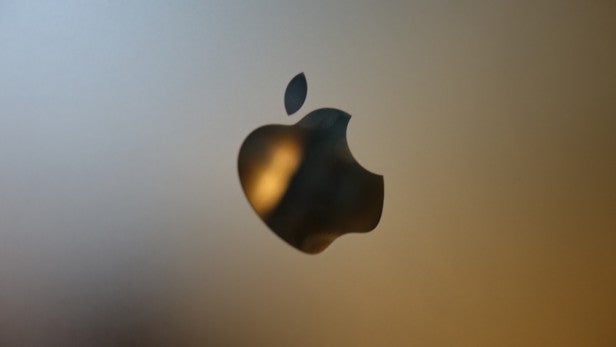
MacBook Pro 2016 – Keyboard and Touchpad
Apple has overhauled both the keyboard and touchpad on the MacBook Pro 2016.
The most obvious change is the trackpad: it’s huge. Measuring in at roughly 13.5cm wide and 8.5cm deep, it’s the biggest touchpad I’ve ever used. There’s effectively limitless room for your fingers to swipe, tap and gesture. I never once bounced off the side or had to reposition my digits. 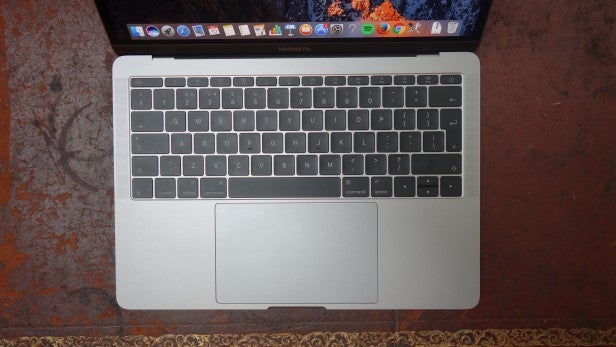
Frankly, it feels almost too big, but since the size of the trackpad isn’t compromising any other part of this machine’s physical build, it’s a fine addition. Apple has done decent work on palm-rejection tech, too, so even if your palms rest on the touchpad, it shouldn’t register an input.
The touchpad works seamlessly with macOS, with no delay at all between gestures and the action being relayed on-screen. It also uses Force Touch, which means clicks are simulated by a haptic feedback motor under the keyboard. It’s also pressure sensitive so if, for example, you press harder on the fast forward arrow on QuickTime the video will move forward more quickly than with a light touch. Force Touch actions give you extra contextual actions such as previewing a link in Safari or peeking at an app in the Launchpad.
Unlike some laptops, where it’s impossible to register a physical click a the top of the touchpad (because it’s where the hinge goes), you can click anywhere on the touchpad and get a response.
As good as Microsoft-certified Precision Touchpads have become, Apple still has the edge here.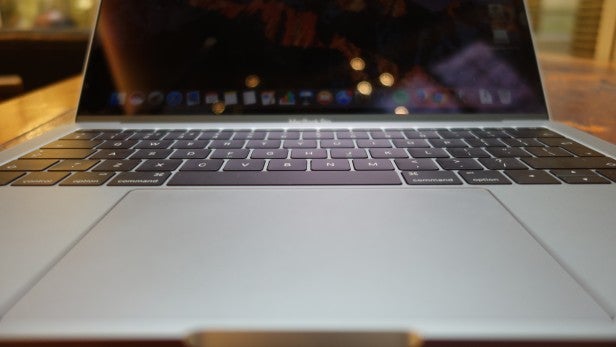
Above the trackpad is Apple’s new Butterfly 2 keyboard. It’s an ultra-low-travel key switch design that’s unique to Apple, similar to that used on the 12-inch MacBook.
Butterfly 2 is greatly improved here, with a much more positive and definite action. It’s also quite noisy if you hit the keys with any force, but near-silent with a more gentle approach. The keys are large and tightly packed, but their grippy texture and slightly concave moulding meant I never missed a stroke.
It won’t suit everyone, and I strongly suggest you try it out in an Apple Store – but for me, the keyboard on the MacBook Pro is the best I’ve ever used.
How we test laptops
Unlike other sites, we test every laptop we review thoroughly over an extended period of time. We use industry standard tests to compare features properly. We’ll always tell you what we find. We never, ever, accept money to review a product.


